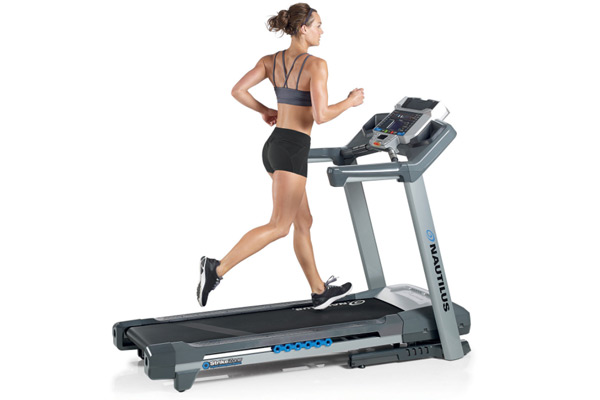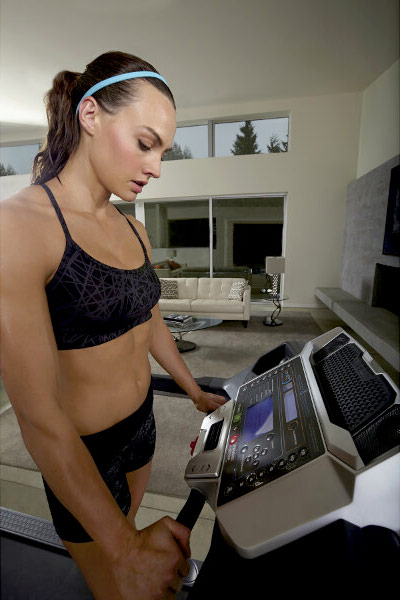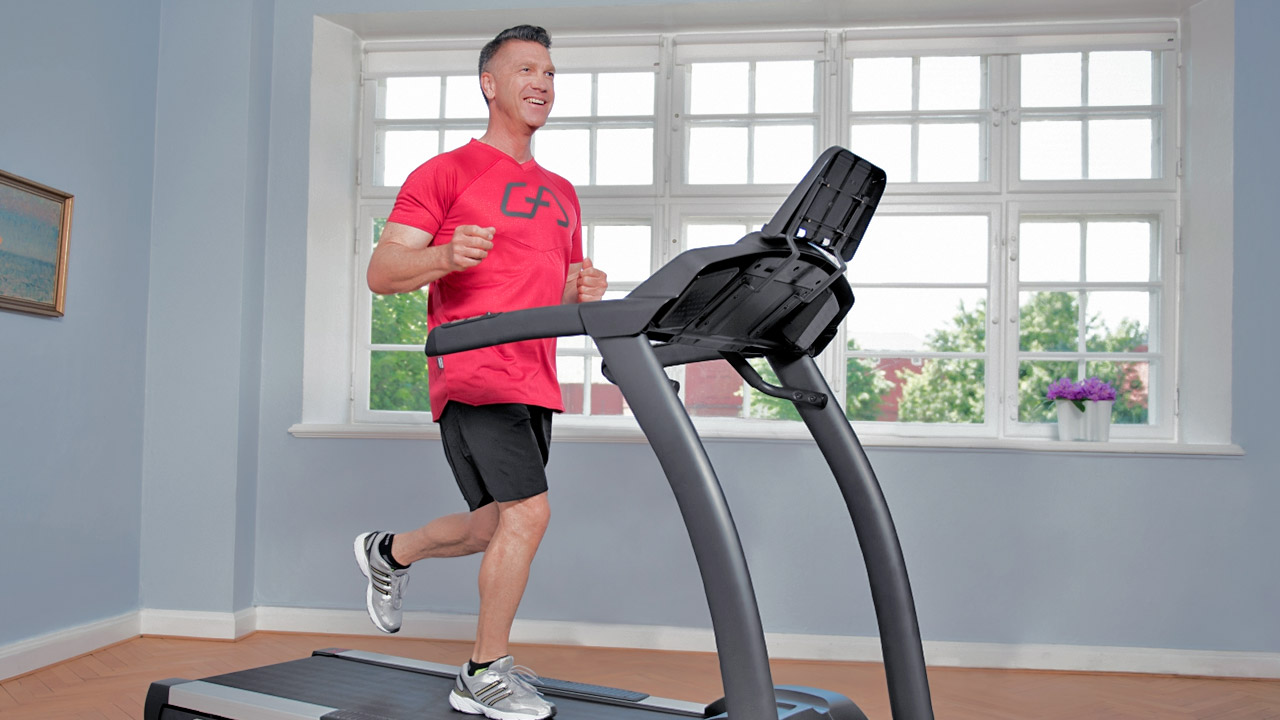High-intensity interval training (HIIT) is a staple in just about everyone’s cardio workout routine, but there may be a better way of doing it.
The research behind sprinting for fat loss and improving performance
There’s little doubt that sprinting is the fastest route to finance your lean ambitions.
In fact, research in the European Journal of Applied Physiology and Occupational Physiology found sprinters have a higher lean-body mass than marathon runners, despite burning significantly fewer calories when training.
Just look at the starter’s blocks of the 100m finals at any athletics meet and the evidence will be clear: lean-muscled physiques reminiscent of a stone-carved Greek statue.
They got that way through sprinting, and high-intensity interval training (HIIT) has had the highest success rate for burning fat and improving performance. The positive research continues to mount.

One of the best ways to do your HIIT or SMIT workouts without any impact is on the Nautilus T626 treadmill. It tracks all of your workouts and transmits your results to their app via bluetooth.
A 2013 study at the Norwegian University of Science and Technology found that four sets of sprinting for one minute then walking for three minutes (preceded by a warm-up and followed by a cool-down) split into three sessions a week can increase VO2 max by a staggering 13% and burn significant amounts of body fat.
Though that might seem like irrefutable evidence that HIIT is the top dog, there is a far better way – taking it easy after your sprint.
Meet SMIT – the new fat-burning kid on the block
HIIT is actually less effective than SMIT (Supra-maximal interval training)
The difference between the two systems? HIIT gets you to run intervals then jog to recover while SMIT has you sprinting intervals then doing nothing afterwards to recover.
So how is it that doing nothing is better than doing something?
Well, research in the Journal of Sports Science compared HIIT and SMIT and found that SMIT lets you work at higher intensities, burning more oxygen and calories and creating more endurance.
So bringing yourself to a grinding halt after your sprint will help you catch your breath, which allows your energy systems to fully recover.
That means you can then sprint again at 100% effort, making sure you’re giving the work portion of your workout absolutely everything you have, much like you would on your maximum lift in the weights room.
One of the most popular SMIT cardio routines you may have heard of is the Tabata workout
The problem with HIIT
While HIIT does sport mountains of research, these studies are done with a sports physiologist close to hand who can monitor the participant’s intensity and heart rate.
In other words, there is someone there to take the athlete to the edge then slowly ease them away from it.
But in the real world that doesn’t always cut it because people who might not be very fit have heard that alternating between sprinting and light jogging is the best way to burn fat, yet they perhaps can’t physically or mentally bring themselves to reach that high intensity point that delivers the results.
So while most think they’re doing HIIT (90–95% of max effort) they are actually just doing plain interval training (80–85% of max effort).
However, getting them to sprint then chill out is a far more effective way of training because they’re probably getting tired in the recovery section of the HIIT anyway. This can give both trained and untrained people far better results.
Putting SMIT into action
The above research that compared the two modalities found the following protocols were the best at increasing performance.
Sprint for 30 seconds at 130% of your VO2 max then rest completely for 150 seconds. Repeat 7–12 sets of this. Do this two to four times a week to improve your performance.
If you don’t know your VO2 max don’t worry too much, the Nautilus T626 comes with an awesome feature that calculates your VO2 Max based on your last five workouts.
It calculates this from time, distance covered and your average heart rate during your previous workouts.
You can also figure it out using the method below – or you can just run like you’re being chased by a pride of lionesses and you’ll probably be close to it. But the Nautilus treadmill is our preferred, hands-off approach.

Want to do it outdoors?
On some days, you might fancy a change in scenery, but bear in mind that hitting the concrete regularly can impact on your joints
(This doesn’t happen on the Nautilus T626 as their StrikeZone technology provides cushioning and give with every step)
Here’s an outdoor protocol:
1. Place two cones 50m apart. Sprint as fast as possible between them three times then take a two-minute do-nothing rest.
2. Sprint as fast as you can between the cones four times then take a two-minute rest.
3. Sprint five times between the cones then take a two-minute rest.
4. Sprint six times between the cones then take a three-minute rest.
5. Sprint seven times between the cones then take a three-minute rest.
6. Jog slowly for four minutes to recover.
Figure Out Your VO2 Max
You can get rigged like an ICU patient to get your VO2 max tested in a lab, use the Nautilus T626 treadmill for an automatic reading after five uses (our recommendation), or use this simple method proven to be accurate according to a study in The Clinical Journal of Investigation.
It’s called the Bruce protocol and is the easiest way of figuring out your VO2 max in your gym or on your home treadmill.
Warm up for 5–10 minutes Start the treadmill at a speed of 2.74kph (1.7mph), set to an incline of 10%. Round up the speeds if your treadmill’s increments aren’t that small.
Jump on and start a stopwatch. Every three minutes increase the speed and slope of the treadmill as per our table below and run until you can’t move your legs.
| STAGE | TIME | KM/HR | INCLINE |
|---|---|---|---|
| 1 | 0 | 2.74 | 10% |
| 2 | 3 | 4.02 | 12% |
| 3 | 6 | 5.47 | 14% |
| 4 | 9 | 6.76 | 16% |
| 5 | 12 | 8.05 | 18% |
| 6 | 15 | 8.85 | 20% |
| 7 | 18 | 9.65 | 22% |
| 8 | 21 | 10.46 | 24% |
| 9 | 24 | 11.26 | 26% |
| 10 | 27 | 12.07 | 28% |
You’ll likely need an incline trainer like the NordicTrack X7i or X9i for this test to be accurate, which is why the Nautilus T626 treadmill is so handy, automatically calculating your VO2 Max.
Record the time and speed you were at when you stopped. This is the speed your V02 max can be achieved at. Now feed your time into this equation (‘T’ is time in minutes):
VO2 max = 2.94 x T + 7.65
So if you lasted 9.25 minutes your calculation would like this:
2.94 x 9.25 + 7.65 = 34,85
The Nautilus T626 treadmill features a 19km/h top speed and 0-15% incline, Bluetooth Smart® connectivity for synching with NautilusConnect™ and MyFitnessPal™, Strike Zone™ cushioning, 26 workouts, wireless heart rate monitoring and SoftDrop™ folding. For more information click here
For more content about HIIT, SMIT and other cardio workout plans, sign up for your FREE TrainMag issue here.







